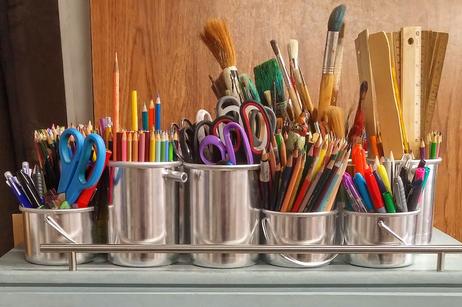Whoever said, ŌĆ£There is no such thing as a free lunch,ŌĆØ could have easily been referring to the state of public education today. In addition to the rising cost of school lunches, many other components of the so-called ŌĆ£freeŌĆØ education system in the United States are also increasing in price. As parents prepare to pack their children off for the world of academia in just a few short weeks, it is wise to weigh the cost of such an endeavor to avoid the sticker shock that many parents face today.
BYOS (Bring Your Own Supplies)
Parents who grew up in school systems that provided supplies to students are often surprised by the long supply lists they are expected to fill before the school year begins. The reports that one Brooklyn mother spent more than $300 on supplies to equip her two first-graders for their year at Public School 130 last year. Included on the list were items like construction paper, crayons, and markers.
However, this parent might have gotten off relatively easy for this school year, as other parents reported purchases of graphing calculators to the tune of $300 apiece and other expensive equipment. Others cite lists that include basic necessities for the classroom, such as hand sanitizer, soap, and paper towels. One parent even told the New York Times that rugs for the classroom turned up on one of her recent supply lists.
Tina Manis, a parent of a New Voices School of Academic and Creative Arts student in Sunset Park, Brooklyn, told the New York Times that she spent more than $400 on school supplies to equip her sixth grader last year, calling the requirement ŌĆ£criminal.ŌĆØ Manis stated to the New York Times, ŌĆ£This is a public school. They didnŌĆÖt even have rulers or tape.ŌĆØ
the need for supplies doesnŌĆÖt always end with the initial list either. The publication received numerous reports from parents about the need for expensive runs to the craft store whenever a new class project was announced. Students also require technology to keep up with assignments in the form of their own personal laptops, notebooks, or iPads. This need may begin as early as middle school and continues all the way through the college years today.
This video offers an overview of back-to-school preparation.
The Hefty Price of Hitting the Road
Field trips are another expense throughout the school year that has increased significantly in recent years. Today, students must foot the bill for bus service to and from their location in many school districts, adding anywhere from $5 to $10 to every trip. In addition, the afternoon outing is often replaced with overnight trips that can cost parents well over $100 a trip.
Students in high school may even have the opportunity to embark on global journeys that take them overseas to exotic locations for learning experiences. According to the New York Times, these trips cost anywhere from $1,000 to $3,500, depending on the destination and the length of the stay. While these trips used to be reserved for very specific occasions, today, long-distance field trips have become much more common, and many parents feel they have no choice but to foot the hefty bill.
This video offers more suggestions for back-to-school preparation.
The Cost of Extracurricular Activities
Another unexpected cost many parents encounter throughout the school year involves extracurricular activities. The days of free theatre productions, sporting events, and clubs are long gone, thanks to dwindling budgets that offer no additional money for after-school options. Today, parents are expected to foot the bill if their children want to broaden their horizons beyond school hours, paying for everything from sports uniforms to sets and props for the school play.
One family who was footing the bill to nurture their daughterŌĆÖs interest in theatre was put in a difficult spot when their student decided she would like to try her hand at softball as well. The mother of the student, Tamara Krause, told U.S. News and World Report, ŌĆ£[My daughter] was also talking about wanting to get into softball, and we were like, ŌĆśWell, we donŌĆÖt know if we can afford the equipment if you want to continue to do drama.ŌĆÖ ItŌĆÖs getting ridiculous cost-wise, to continue to fund all these things through school.ŌĆØ
Footing the Bill for the PTA
As schools are finding themselves with less disposable funding to invest in their students, many districts are turning to fundraising to bridge the gaps in the budget. Who is responsible for footing the fundraising bill? The parents, of course, often through the parent-teacher organization known traditionally as the PTA.
The reports that PTAs are now helping their schools fund a wide range of extras, including:
- Staff, such as teaching assistants, special teachers, and substitutes
- Field trips, including overnight visits
- New school features that enhance the learning experience
- Enrichment courses for students
In some ways, the PTA has brought the public schools they serve to private school status in terms of the services and amenities they have allowed the schools to offer. However, some voice concern that this trend is widening the disparity between wealthy and poor schools since the funding comes directly from the pockets of parents. Schools that donŌĆÖt have the benefit of wealthy parents are missing out on many of the benefits offered at better-endowed schools nearby.
The cost of educating children continues to rise, even as funding for schools continues to be problematic for states. As this trend continues, it appears parents will be increasingly called upon to maintain their children's educational quality through their own pocketbooks.
Questions? Contact us on Facebook. @publicschoolreview












